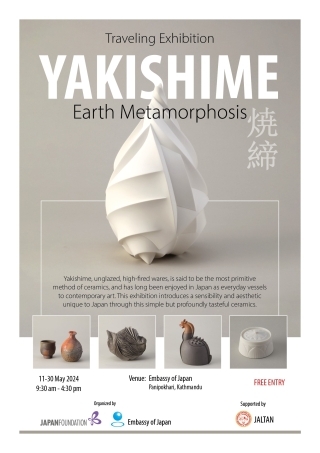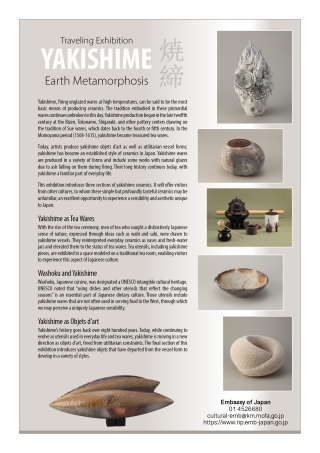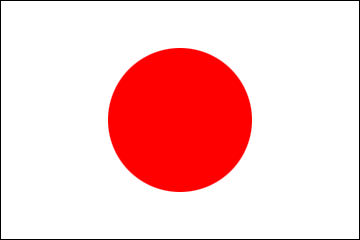Japan Foundation Traveling Exhibition “YAKISHIME: Earth Metamorphosis” (May 9, 2024)
2024/5/9


JEINF No. 19-2024
May 9, 2024
Japan Foundation Traveling Exhibition “YAKISHIME: Earth Metamorphosis”
The Embassy of Japan and the Japan Foundation, to introduce and promote Japanese culture to the people of Nepal, are going to hold an exhibition "YAKISHIME: Earth Metamorphosis" at the Embassy Hall, Panipokhari, Kathmandu. The exhibition will remain open for free to the general public from May 11 (Sat.) to 30 (Thu.) from 9.30 a.m. to 4.30 p.m. everyday.
Ceramics, whether pottery, porcelain, or earthenware, are produced throughout the world, wherever clay, the essential raw material, and wood for firing can be found. The Japanese tradition of using of yakishime, unglazed, high-fired wares, for serving food and drink may, however, be unique.
The exhibition introduces yakishime ceramics, which developed in distinctive directions in Japan, as a part of Japanese traditional culture. It explores the history of yakishime, from its origins to the present, its use in tea wares and utensils for serving food, and its emergence as objets d’art. It will offer visitors from other cultures, to whom these simple but profoundly tasteful ceramics may be unfamiliar, an excellent opportunity to experience the sensibility and aesthetic unique to Japan.
Both Nepali and Japanese peoples embrace traditional culture and crafts as well as contemporary art. It is hoped that the visitors will, through experiencing this generous array of yakishime wares, find the depth and diversity of Japanese culture and gain insight into its creativity.
Ceramics, whether pottery, porcelain, or earthenware, are produced throughout the world, wherever clay, the essential raw material, and wood for firing can be found. The Japanese tradition of using of yakishime, unglazed, high-fired wares, for serving food and drink may, however, be unique.
The exhibition introduces yakishime ceramics, which developed in distinctive directions in Japan, as a part of Japanese traditional culture. It explores the history of yakishime, from its origins to the present, its use in tea wares and utensils for serving food, and its emergence as objets d’art. It will offer visitors from other cultures, to whom these simple but profoundly tasteful ceramics may be unfamiliar, an excellent opportunity to experience the sensibility and aesthetic unique to Japan.
Both Nepali and Japanese peoples embrace traditional culture and crafts as well as contemporary art. It is hoped that the visitors will, through experiencing this generous array of yakishime wares, find the depth and diversity of Japanese culture and gain insight into its creativity.
